NUR09714 Essay: Learning, Teaching & Assessment in Healthcare
VerifiedAdded on 2022/11/19
|14
|4608
|61
Essay
AI Summary
This essay delves into the crucial aspects of learning, teaching, and assessment within a healthcare environment, specifically addressing the challenges of mentoring an underachieving student. It begins by defining the characteristics of such a student, highlighting factors such as lack of focus, self-confidence, and integration of goals. The essay then outlines the key qualities of an effective mentor, emphasizing communication, preparedness, active listening, honesty, fairness, and the ability to encourage students to step outside their comfort zones. Various learning styles, including andragogy/pedagogy, cognitive, and behavioral approaches, are discussed to provide mentors with diverse strategies to support student learning. The application of these learning styles is explored in the context of the clinical environment, emphasizing the importance of a supportive and engaging atmosphere. A SWOT analysis is presented to evaluate the strengths, weaknesses, opportunities, and threats associated with mentoring, followed by a discussion of assessment methods designed to promote learning in practice. The essay concludes with recommendations for mentors and reflects on how the learning gained can be applied to future mentoring practice, providing a comprehensive guide to fostering student success in healthcare education.
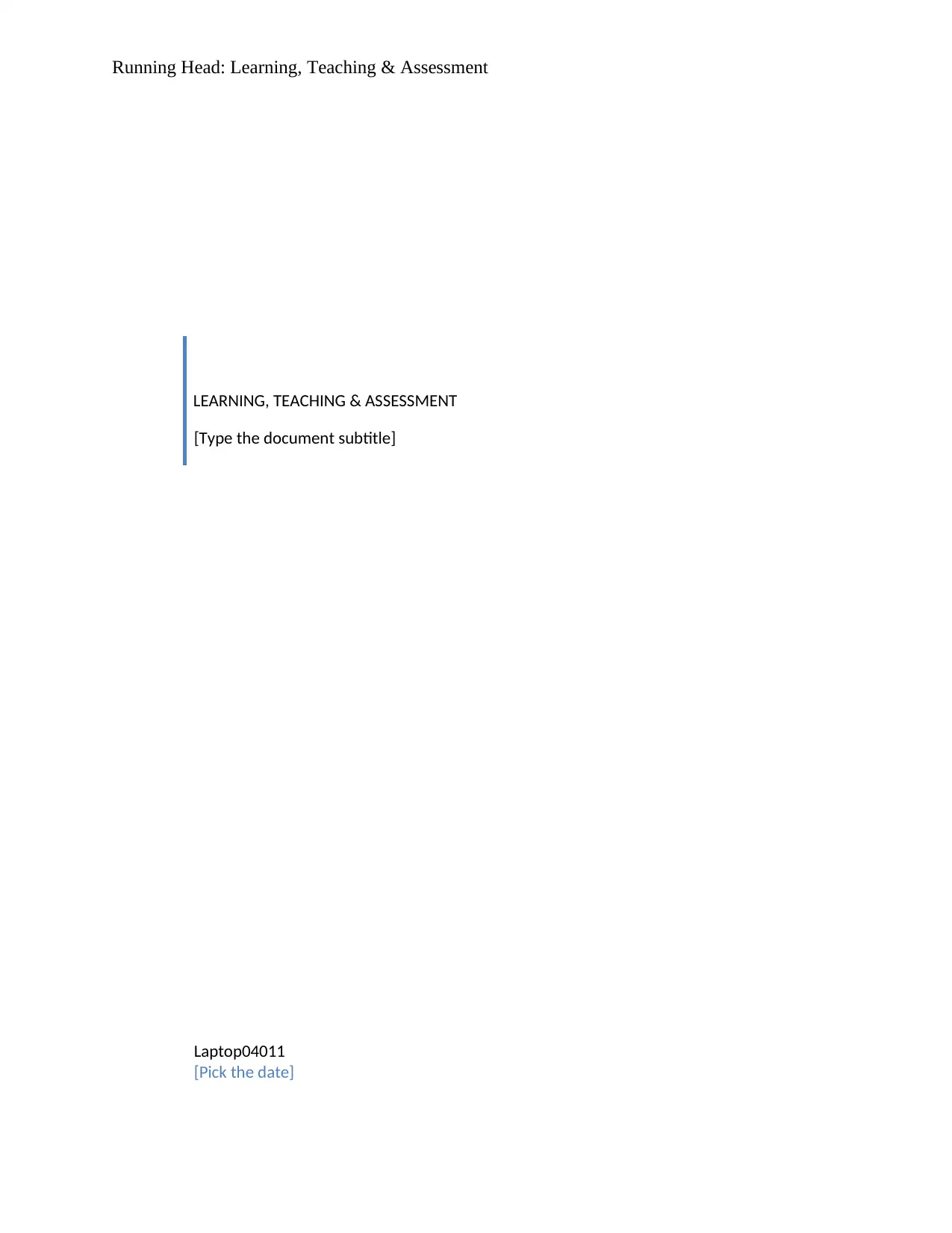
Running Head: Learning, Teaching & Assessment
LEARNING, TEACHING & ASSESSMENT
[Type the document subtitle]
Laptop04011
[Pick the date]
LEARNING, TEACHING & ASSESSMENT
[Type the document subtitle]
Laptop04011
[Pick the date]
Paraphrase This Document
Need a fresh take? Get an instant paraphrase of this document with our AI Paraphraser
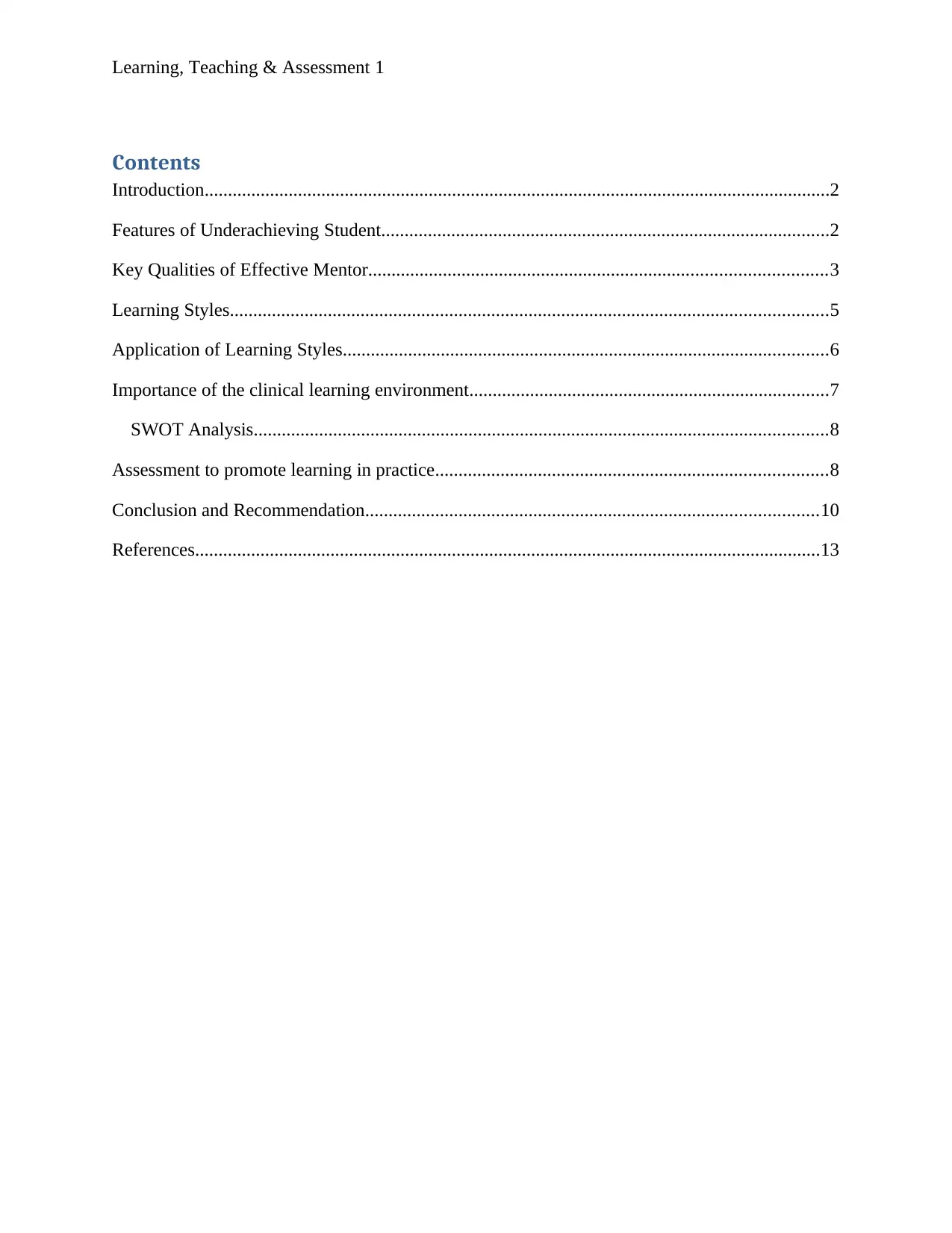
Learning, Teaching & Assessment 1
Contents
Introduction......................................................................................................................................2
Features of Underachieving Student................................................................................................2
Key Qualities of Effective Mentor..................................................................................................3
Learning Styles................................................................................................................................5
Application of Learning Styles........................................................................................................6
Importance of the clinical learning environment.............................................................................7
SWOT Analysis...........................................................................................................................8
Assessment to promote learning in practice....................................................................................8
Conclusion and Recommendation.................................................................................................10
References......................................................................................................................................13
Contents
Introduction......................................................................................................................................2
Features of Underachieving Student................................................................................................2
Key Qualities of Effective Mentor..................................................................................................3
Learning Styles................................................................................................................................5
Application of Learning Styles........................................................................................................6
Importance of the clinical learning environment.............................................................................7
SWOT Analysis...........................................................................................................................8
Assessment to promote learning in practice....................................................................................8
Conclusion and Recommendation.................................................................................................10
References......................................................................................................................................13

Learning, Teaching & Assessment 2
Introduction
The purpose of this paper is to highlight the details about the need and importance of
learning and effective mentorship in the business environment. The paper highlights information
about the case of an underachieving student who is failing to achieve expected grades in the
environment. Further, it should be noted that the key quality of an effective leader are defined in
the paper. It is important for a mentor to possess several qualities in the environment so as to
provide success to the students in the environment (Gaunt et al, 2012). Further, several learning
styles are also evaluated in the report so as to analyse the ways in which the mentor can
effectively help the student achieve their objectives in the professional environment. Importance
of clinical learning environment is discussed to guide the reader with the clinical practices that
are important. Action plan will help in achieving and implementation of the objectives in the
environment. More details about the paper are discussed below:
Features of Underachieving Student
An underachieving student is a person in the educational environment who is not
achieving grades as per their calibre and skills present with them. Every person in the
environment possesses several skills and capabilities that differentiate them from other people
(Damber, Samuelsson, & Taube, 2012). It is important for the students to induce their complete
efficiency in the project so as to achieve desired objectives in the environment. In the given case
of clinical setting, the underachieving student possesses lack of interest in clinical practices. The
student who needs mentoring in the given case is distracted from his desired path and need
attention and focuses so that he can effectively prioritize important things in life. In the clinical
practice and studies, the student requires going deep into the studies and spending hours to
complete the vast course then only then can achieve success in the environment. The clinical
studies is tough and requires concentration due to it expanded courses resulting in which small
distraction can also make the student suffer in long term (Olson et al, 2013).
The student lacks focus and attention in the right direction due to which he is failing in
the educational environment. He also lacks integration of goal and self-direction as the education
of clinical practices in the environment. It is important for every student to learn and integrate
Introduction
The purpose of this paper is to highlight the details about the need and importance of
learning and effective mentorship in the business environment. The paper highlights information
about the case of an underachieving student who is failing to achieve expected grades in the
environment. Further, it should be noted that the key quality of an effective leader are defined in
the paper. It is important for a mentor to possess several qualities in the environment so as to
provide success to the students in the environment (Gaunt et al, 2012). Further, several learning
styles are also evaluated in the report so as to analyse the ways in which the mentor can
effectively help the student achieve their objectives in the professional environment. Importance
of clinical learning environment is discussed to guide the reader with the clinical practices that
are important. Action plan will help in achieving and implementation of the objectives in the
environment. More details about the paper are discussed below:
Features of Underachieving Student
An underachieving student is a person in the educational environment who is not
achieving grades as per their calibre and skills present with them. Every person in the
environment possesses several skills and capabilities that differentiate them from other people
(Damber, Samuelsson, & Taube, 2012). It is important for the students to induce their complete
efficiency in the project so as to achieve desired objectives in the environment. In the given case
of clinical setting, the underachieving student possesses lack of interest in clinical practices. The
student who needs mentoring in the given case is distracted from his desired path and need
attention and focuses so that he can effectively prioritize important things in life. In the clinical
practice and studies, the student requires going deep into the studies and spending hours to
complete the vast course then only then can achieve success in the environment. The clinical
studies is tough and requires concentration due to it expanded courses resulting in which small
distraction can also make the student suffer in long term (Olson et al, 2013).
The student lacks focus and attention in the right direction due to which he is failing in
the educational environment. He also lacks integration of goal and self-direction as the education
of clinical practices in the environment. It is important for every student to learn and integrate
⊘ This is a preview!⊘
Do you want full access?
Subscribe today to unlock all pages.

Trusted by 1+ million students worldwide
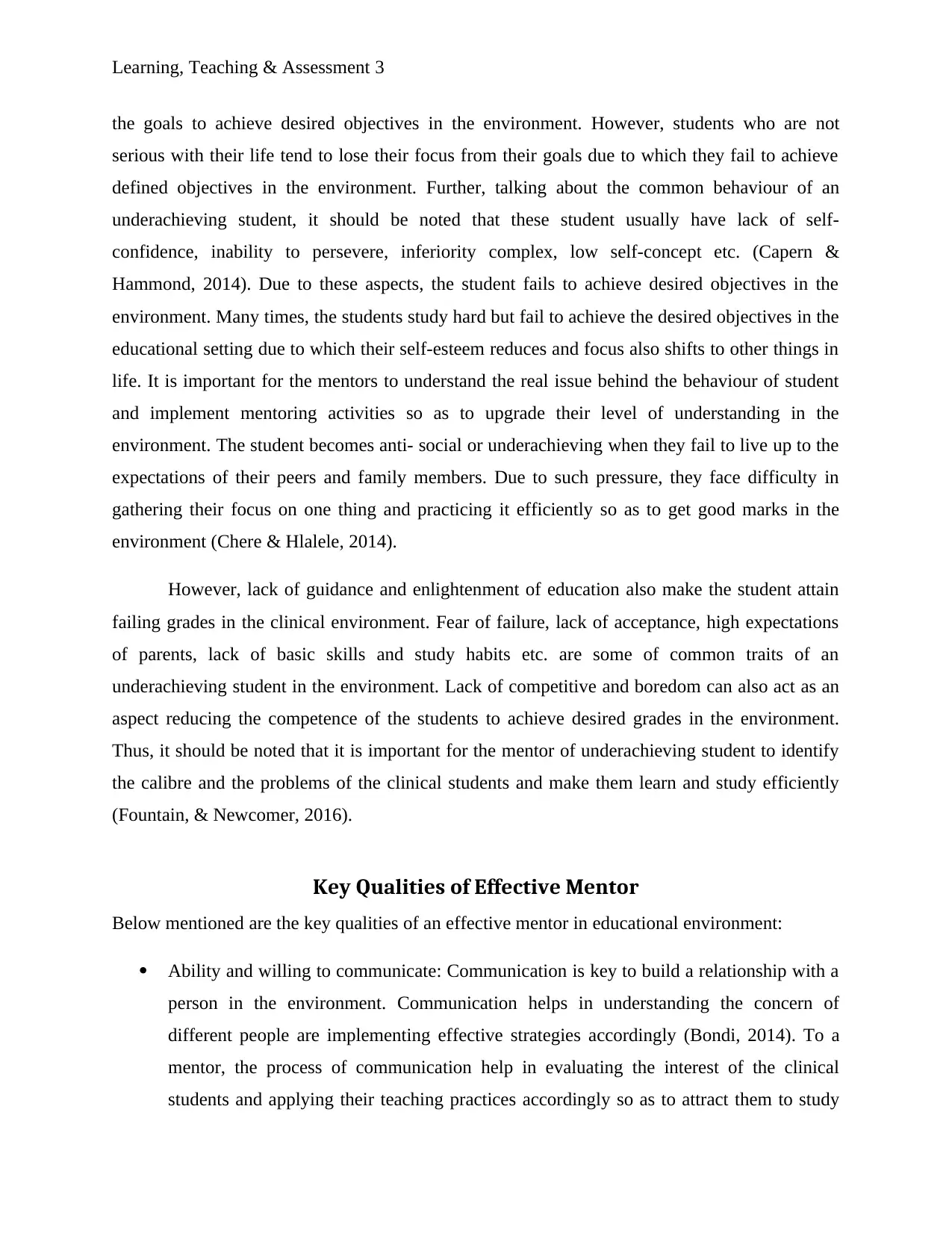
Learning, Teaching & Assessment 3
the goals to achieve desired objectives in the environment. However, students who are not
serious with their life tend to lose their focus from their goals due to which they fail to achieve
defined objectives in the environment. Further, talking about the common behaviour of an
underachieving student, it should be noted that these student usually have lack of self-
confidence, inability to persevere, inferiority complex, low self-concept etc. (Capern &
Hammond, 2014). Due to these aspects, the student fails to achieve desired objectives in the
environment. Many times, the students study hard but fail to achieve the desired objectives in the
educational setting due to which their self-esteem reduces and focus also shifts to other things in
life. It is important for the mentors to understand the real issue behind the behaviour of student
and implement mentoring activities so as to upgrade their level of understanding in the
environment. The student becomes anti- social or underachieving when they fail to live up to the
expectations of their peers and family members. Due to such pressure, they face difficulty in
gathering their focus on one thing and practicing it efficiently so as to get good marks in the
environment (Chere & Hlalele, 2014).
However, lack of guidance and enlightenment of education also make the student attain
failing grades in the clinical environment. Fear of failure, lack of acceptance, high expectations
of parents, lack of basic skills and study habits etc. are some of common traits of an
underachieving student in the environment. Lack of competitive and boredom can also act as an
aspect reducing the competence of the students to achieve desired grades in the environment.
Thus, it should be noted that it is important for the mentor of underachieving student to identify
the calibre and the problems of the clinical students and make them learn and study efficiently
(Fountain, & Newcomer, 2016).
Key Qualities of Effective Mentor
Below mentioned are the key qualities of an effective mentor in educational environment:
Ability and willing to communicate: Communication is key to build a relationship with a
person in the environment. Communication helps in understanding the concern of
different people are implementing effective strategies accordingly (Bondi, 2014). To a
mentor, the process of communication help in evaluating the interest of the clinical
students and applying their teaching practices accordingly so as to attract them to study
the goals to achieve desired objectives in the environment. However, students who are not
serious with their life tend to lose their focus from their goals due to which they fail to achieve
defined objectives in the environment. Further, talking about the common behaviour of an
underachieving student, it should be noted that these student usually have lack of self-
confidence, inability to persevere, inferiority complex, low self-concept etc. (Capern &
Hammond, 2014). Due to these aspects, the student fails to achieve desired objectives in the
environment. Many times, the students study hard but fail to achieve the desired objectives in the
educational setting due to which their self-esteem reduces and focus also shifts to other things in
life. It is important for the mentors to understand the real issue behind the behaviour of student
and implement mentoring activities so as to upgrade their level of understanding in the
environment. The student becomes anti- social or underachieving when they fail to live up to the
expectations of their peers and family members. Due to such pressure, they face difficulty in
gathering their focus on one thing and practicing it efficiently so as to get good marks in the
environment (Chere & Hlalele, 2014).
However, lack of guidance and enlightenment of education also make the student attain
failing grades in the clinical environment. Fear of failure, lack of acceptance, high expectations
of parents, lack of basic skills and study habits etc. are some of common traits of an
underachieving student in the environment. Lack of competitive and boredom can also act as an
aspect reducing the competence of the students to achieve desired grades in the environment.
Thus, it should be noted that it is important for the mentor of underachieving student to identify
the calibre and the problems of the clinical students and make them learn and study efficiently
(Fountain, & Newcomer, 2016).
Key Qualities of Effective Mentor
Below mentioned are the key qualities of an effective mentor in educational environment:
Ability and willing to communicate: Communication is key to build a relationship with a
person in the environment. Communication helps in understanding the concern of
different people are implementing effective strategies accordingly (Bondi, 2014). To a
mentor, the process of communication help in evaluating the interest of the clinical
students and applying their teaching practices accordingly so as to attract them to study
Paraphrase This Document
Need a fresh take? Get an instant paraphrase of this document with our AI Paraphraser
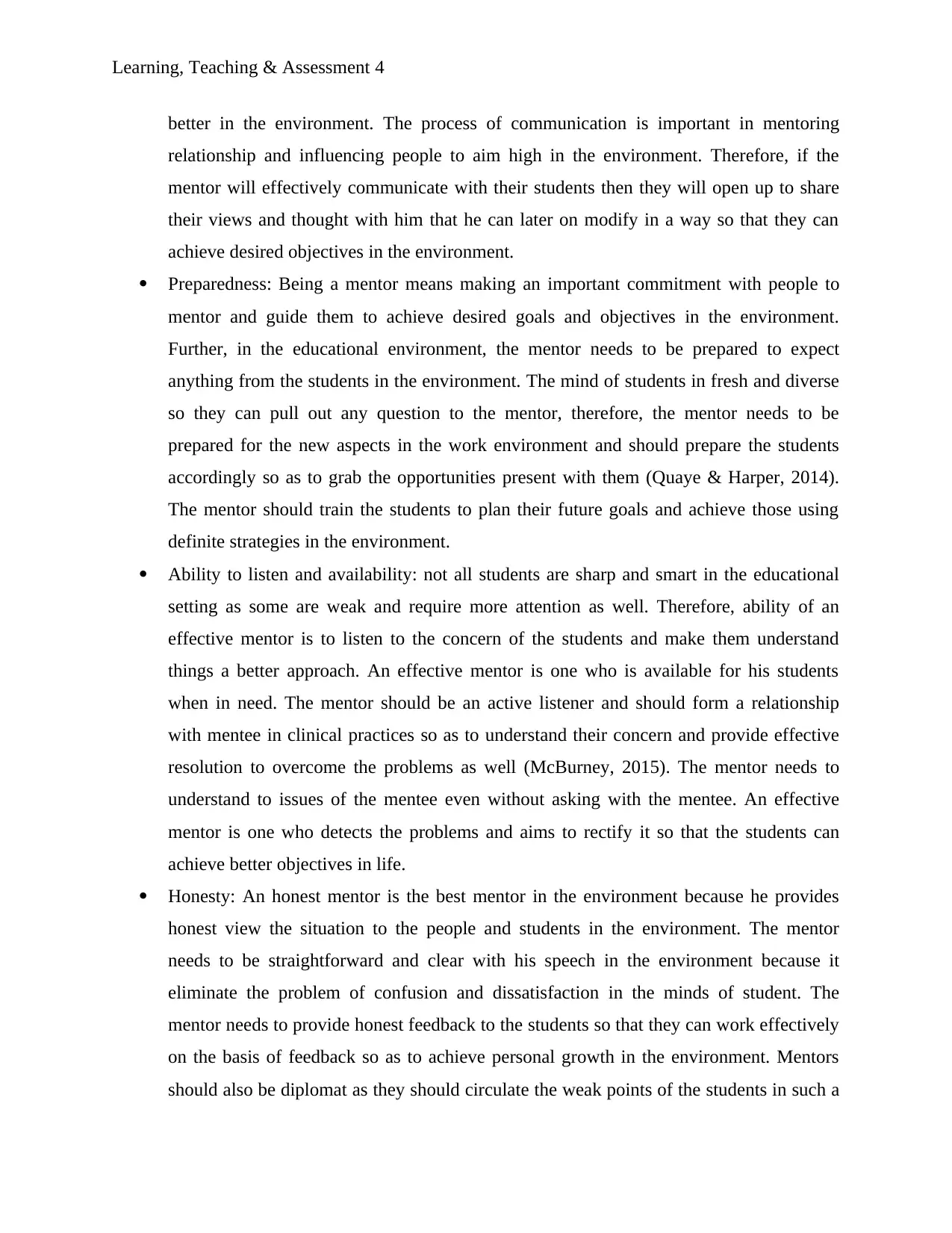
Learning, Teaching & Assessment 4
better in the environment. The process of communication is important in mentoring
relationship and influencing people to aim high in the environment. Therefore, if the
mentor will effectively communicate with their students then they will open up to share
their views and thought with him that he can later on modify in a way so that they can
achieve desired objectives in the environment.
Preparedness: Being a mentor means making an important commitment with people to
mentor and guide them to achieve desired goals and objectives in the environment.
Further, in the educational environment, the mentor needs to be prepared to expect
anything from the students in the environment. The mind of students in fresh and diverse
so they can pull out any question to the mentor, therefore, the mentor needs to be
prepared for the new aspects in the work environment and should prepare the students
accordingly so as to grab the opportunities present with them (Quaye & Harper, 2014).
The mentor should train the students to plan their future goals and achieve those using
definite strategies in the environment.
Ability to listen and availability: not all students are sharp and smart in the educational
setting as some are weak and require more attention as well. Therefore, ability of an
effective mentor is to listen to the concern of the students and make them understand
things a better approach. An effective mentor is one who is available for his students
when in need. The mentor should be an active listener and should form a relationship
with mentee in clinical practices so as to understand their concern and provide effective
resolution to overcome the problems as well (McBurney, 2015). The mentor needs to
understand to issues of the mentee even without asking with the mentee. An effective
mentor is one who detects the problems and aims to rectify it so that the students can
achieve better objectives in life.
Honesty: An honest mentor is the best mentor in the environment because he provides
honest view the situation to the people and students in the environment. The mentor
needs to be straightforward and clear with his speech in the environment because it
eliminate the problem of confusion and dissatisfaction in the minds of student. The
mentor needs to provide honest feedback to the students so that they can work effectively
on the basis of feedback so as to achieve personal growth in the environment. Mentors
should also be diplomat as they should circulate the weak points of the students in such a
better in the environment. The process of communication is important in mentoring
relationship and influencing people to aim high in the environment. Therefore, if the
mentor will effectively communicate with their students then they will open up to share
their views and thought with him that he can later on modify in a way so that they can
achieve desired objectives in the environment.
Preparedness: Being a mentor means making an important commitment with people to
mentor and guide them to achieve desired goals and objectives in the environment.
Further, in the educational environment, the mentor needs to be prepared to expect
anything from the students in the environment. The mind of students in fresh and diverse
so they can pull out any question to the mentor, therefore, the mentor needs to be
prepared for the new aspects in the work environment and should prepare the students
accordingly so as to grab the opportunities present with them (Quaye & Harper, 2014).
The mentor should train the students to plan their future goals and achieve those using
definite strategies in the environment.
Ability to listen and availability: not all students are sharp and smart in the educational
setting as some are weak and require more attention as well. Therefore, ability of an
effective mentor is to listen to the concern of the students and make them understand
things a better approach. An effective mentor is one who is available for his students
when in need. The mentor should be an active listener and should form a relationship
with mentee in clinical practices so as to understand their concern and provide effective
resolution to overcome the problems as well (McBurney, 2015). The mentor needs to
understand to issues of the mentee even without asking with the mentee. An effective
mentor is one who detects the problems and aims to rectify it so that the students can
achieve better objectives in life.
Honesty: An honest mentor is the best mentor in the environment because he provides
honest view the situation to the people and students in the environment. The mentor
needs to be straightforward and clear with his speech in the environment because it
eliminate the problem of confusion and dissatisfaction in the minds of student. The
mentor needs to provide honest feedback to the students so that they can work effectively
on the basis of feedback so as to achieve personal growth in the environment. Mentors
should also be diplomat as they should circulate the weak points of the students in such a
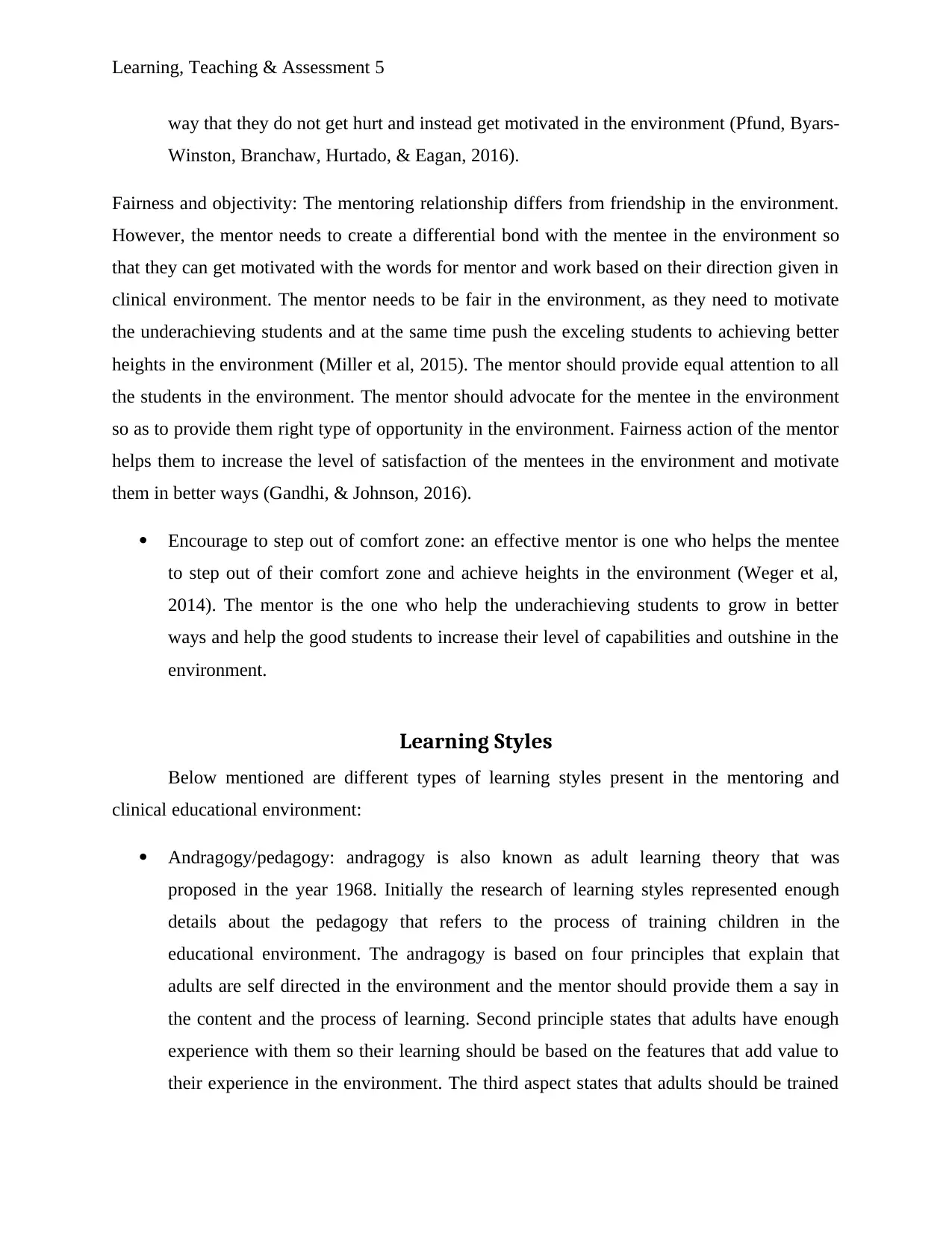
Learning, Teaching & Assessment 5
way that they do not get hurt and instead get motivated in the environment (Pfund, Byars-
Winston, Branchaw, Hurtado, & Eagan, 2016).
Fairness and objectivity: The mentoring relationship differs from friendship in the environment.
However, the mentor needs to create a differential bond with the mentee in the environment so
that they can get motivated with the words for mentor and work based on their direction given in
clinical environment. The mentor needs to be fair in the environment, as they need to motivate
the underachieving students and at the same time push the exceling students to achieving better
heights in the environment (Miller et al, 2015). The mentor should provide equal attention to all
the students in the environment. The mentor should advocate for the mentee in the environment
so as to provide them right type of opportunity in the environment. Fairness action of the mentor
helps them to increase the level of satisfaction of the mentees in the environment and motivate
them in better ways (Gandhi, & Johnson, 2016).
Encourage to step out of comfort zone: an effective mentor is one who helps the mentee
to step out of their comfort zone and achieve heights in the environment (Weger et al,
2014). The mentor is the one who help the underachieving students to grow in better
ways and help the good students to increase their level of capabilities and outshine in the
environment.
Learning Styles
Below mentioned are different types of learning styles present in the mentoring and
clinical educational environment:
Andragogy/pedagogy: andragogy is also known as adult learning theory that was
proposed in the year 1968. Initially the research of learning styles represented enough
details about the pedagogy that refers to the process of training children in the
educational environment. The andragogy is based on four principles that explain that
adults are self directed in the environment and the mentor should provide them a say in
the content and the process of learning. Second principle states that adults have enough
experience with them so their learning should be based on the features that add value to
their experience in the environment. The third aspect states that adults should be trained
way that they do not get hurt and instead get motivated in the environment (Pfund, Byars-
Winston, Branchaw, Hurtado, & Eagan, 2016).
Fairness and objectivity: The mentoring relationship differs from friendship in the environment.
However, the mentor needs to create a differential bond with the mentee in the environment so
that they can get motivated with the words for mentor and work based on their direction given in
clinical environment. The mentor needs to be fair in the environment, as they need to motivate
the underachieving students and at the same time push the exceling students to achieving better
heights in the environment (Miller et al, 2015). The mentor should provide equal attention to all
the students in the environment. The mentor should advocate for the mentee in the environment
so as to provide them right type of opportunity in the environment. Fairness action of the mentor
helps them to increase the level of satisfaction of the mentees in the environment and motivate
them in better ways (Gandhi, & Johnson, 2016).
Encourage to step out of comfort zone: an effective mentor is one who helps the mentee
to step out of their comfort zone and achieve heights in the environment (Weger et al,
2014). The mentor is the one who help the underachieving students to grow in better
ways and help the good students to increase their level of capabilities and outshine in the
environment.
Learning Styles
Below mentioned are different types of learning styles present in the mentoring and
clinical educational environment:
Andragogy/pedagogy: andragogy is also known as adult learning theory that was
proposed in the year 1968. Initially the research of learning styles represented enough
details about the pedagogy that refers to the process of training children in the
educational environment. The andragogy is based on four principles that explain that
adults are self directed in the environment and the mentor should provide them a say in
the content and the process of learning. Second principle states that adults have enough
experience with them so their learning should be based on the features that add value to
their experience in the environment. The third aspect states that adults should be trained
⊘ This is a preview!⊘
Do you want full access?
Subscribe today to unlock all pages.

Trusted by 1+ million students worldwide
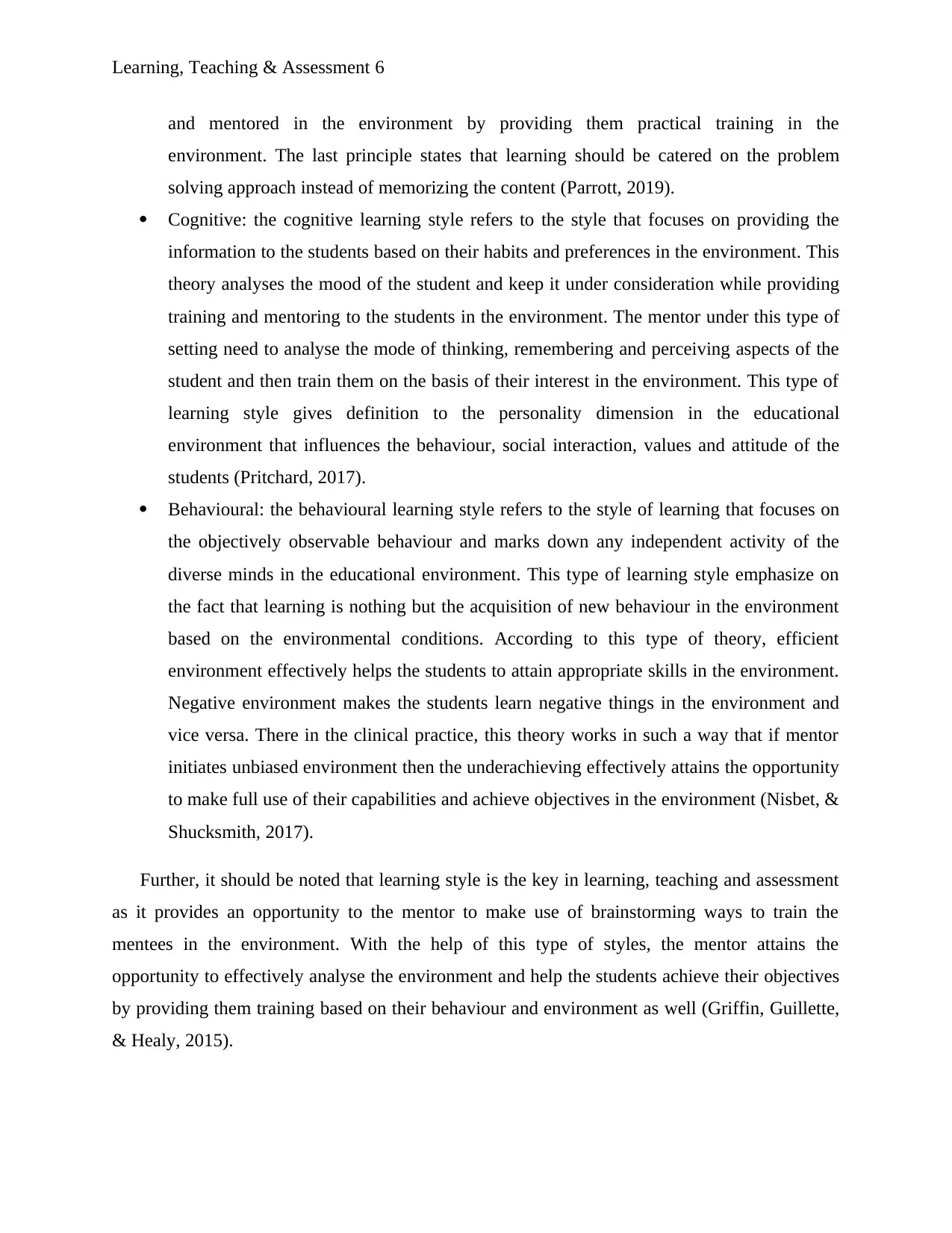
Learning, Teaching & Assessment 6
and mentored in the environment by providing them practical training in the
environment. The last principle states that learning should be catered on the problem
solving approach instead of memorizing the content (Parrott, 2019).
Cognitive: the cognitive learning style refers to the style that focuses on providing the
information to the students based on their habits and preferences in the environment. This
theory analyses the mood of the student and keep it under consideration while providing
training and mentoring to the students in the environment. The mentor under this type of
setting need to analyse the mode of thinking, remembering and perceiving aspects of the
student and then train them on the basis of their interest in the environment. This type of
learning style gives definition to the personality dimension in the educational
environment that influences the behaviour, social interaction, values and attitude of the
students (Pritchard, 2017).
Behavioural: the behavioural learning style refers to the style of learning that focuses on
the objectively observable behaviour and marks down any independent activity of the
diverse minds in the educational environment. This type of learning style emphasize on
the fact that learning is nothing but the acquisition of new behaviour in the environment
based on the environmental conditions. According to this type of theory, efficient
environment effectively helps the students to attain appropriate skills in the environment.
Negative environment makes the students learn negative things in the environment and
vice versa. There in the clinical practice, this theory works in such a way that if mentor
initiates unbiased environment then the underachieving effectively attains the opportunity
to make full use of their capabilities and achieve objectives in the environment (Nisbet, &
Shucksmith, 2017).
Further, it should be noted that learning style is the key in learning, teaching and assessment
as it provides an opportunity to the mentor to make use of brainstorming ways to train the
mentees in the environment. With the help of this type of styles, the mentor attains the
opportunity to effectively analyse the environment and help the students achieve their objectives
by providing them training based on their behaviour and environment as well (Griffin, Guillette,
& Healy, 2015).
and mentored in the environment by providing them practical training in the
environment. The last principle states that learning should be catered on the problem
solving approach instead of memorizing the content (Parrott, 2019).
Cognitive: the cognitive learning style refers to the style that focuses on providing the
information to the students based on their habits and preferences in the environment. This
theory analyses the mood of the student and keep it under consideration while providing
training and mentoring to the students in the environment. The mentor under this type of
setting need to analyse the mode of thinking, remembering and perceiving aspects of the
student and then train them on the basis of their interest in the environment. This type of
learning style gives definition to the personality dimension in the educational
environment that influences the behaviour, social interaction, values and attitude of the
students (Pritchard, 2017).
Behavioural: the behavioural learning style refers to the style of learning that focuses on
the objectively observable behaviour and marks down any independent activity of the
diverse minds in the educational environment. This type of learning style emphasize on
the fact that learning is nothing but the acquisition of new behaviour in the environment
based on the environmental conditions. According to this type of theory, efficient
environment effectively helps the students to attain appropriate skills in the environment.
Negative environment makes the students learn negative things in the environment and
vice versa. There in the clinical practice, this theory works in such a way that if mentor
initiates unbiased environment then the underachieving effectively attains the opportunity
to make full use of their capabilities and achieve objectives in the environment (Nisbet, &
Shucksmith, 2017).
Further, it should be noted that learning style is the key in learning, teaching and assessment
as it provides an opportunity to the mentor to make use of brainstorming ways to train the
mentees in the environment. With the help of this type of styles, the mentor attains the
opportunity to effectively analyse the environment and help the students achieve their objectives
by providing them training based on their behaviour and environment as well (Griffin, Guillette,
& Healy, 2015).
Paraphrase This Document
Need a fresh take? Get an instant paraphrase of this document with our AI Paraphraser
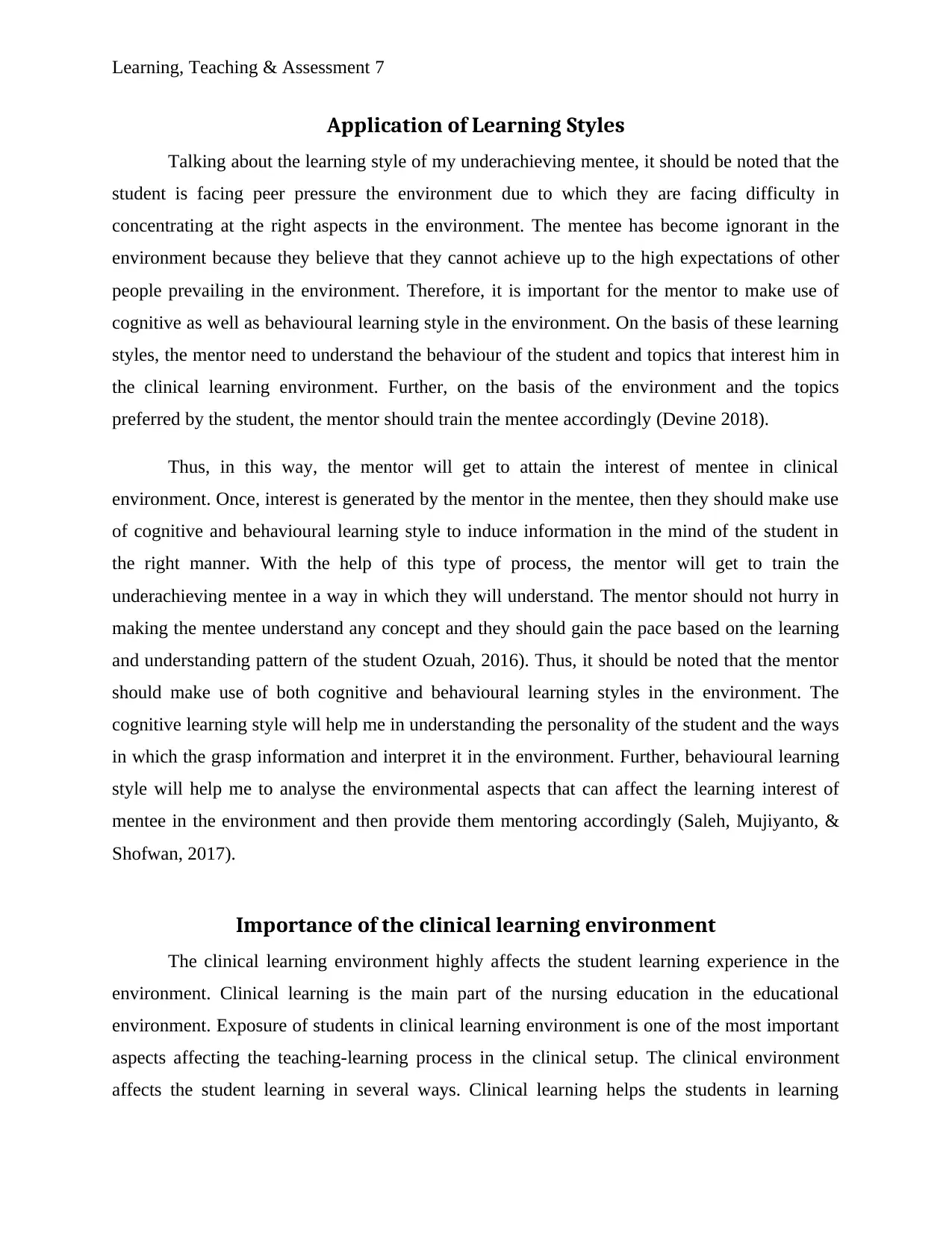
Learning, Teaching & Assessment 7
Application of Learning Styles
Talking about the learning style of my underachieving mentee, it should be noted that the
student is facing peer pressure the environment due to which they are facing difficulty in
concentrating at the right aspects in the environment. The mentee has become ignorant in the
environment because they believe that they cannot achieve up to the high expectations of other
people prevailing in the environment. Therefore, it is important for the mentor to make use of
cognitive as well as behavioural learning style in the environment. On the basis of these learning
styles, the mentor need to understand the behaviour of the student and topics that interest him in
the clinical learning environment. Further, on the basis of the environment and the topics
preferred by the student, the mentor should train the mentee accordingly (Devine 2018).
Thus, in this way, the mentor will get to attain the interest of mentee in clinical
environment. Once, interest is generated by the mentor in the mentee, then they should make use
of cognitive and behavioural learning style to induce information in the mind of the student in
the right manner. With the help of this type of process, the mentor will get to train the
underachieving mentee in a way in which they will understand. The mentor should not hurry in
making the mentee understand any concept and they should gain the pace based on the learning
and understanding pattern of the student Ozuah, 2016). Thus, it should be noted that the mentor
should make use of both cognitive and behavioural learning styles in the environment. The
cognitive learning style will help me in understanding the personality of the student and the ways
in which the grasp information and interpret it in the environment. Further, behavioural learning
style will help me to analyse the environmental aspects that can affect the learning interest of
mentee in the environment and then provide them mentoring accordingly (Saleh, Mujiyanto, &
Shofwan, 2017).
Importance of the clinical learning environment
The clinical learning environment highly affects the student learning experience in the
environment. Clinical learning is the main part of the nursing education in the educational
environment. Exposure of students in clinical learning environment is one of the most important
aspects affecting the teaching-learning process in the clinical setup. The clinical environment
affects the student learning in several ways. Clinical learning helps the students in learning
Application of Learning Styles
Talking about the learning style of my underachieving mentee, it should be noted that the
student is facing peer pressure the environment due to which they are facing difficulty in
concentrating at the right aspects in the environment. The mentee has become ignorant in the
environment because they believe that they cannot achieve up to the high expectations of other
people prevailing in the environment. Therefore, it is important for the mentor to make use of
cognitive as well as behavioural learning style in the environment. On the basis of these learning
styles, the mentor need to understand the behaviour of the student and topics that interest him in
the clinical learning environment. Further, on the basis of the environment and the topics
preferred by the student, the mentor should train the mentee accordingly (Devine 2018).
Thus, in this way, the mentor will get to attain the interest of mentee in clinical
environment. Once, interest is generated by the mentor in the mentee, then they should make use
of cognitive and behavioural learning style to induce information in the mind of the student in
the right manner. With the help of this type of process, the mentor will get to train the
underachieving mentee in a way in which they will understand. The mentor should not hurry in
making the mentee understand any concept and they should gain the pace based on the learning
and understanding pattern of the student Ozuah, 2016). Thus, it should be noted that the mentor
should make use of both cognitive and behavioural learning styles in the environment. The
cognitive learning style will help me in understanding the personality of the student and the ways
in which the grasp information and interpret it in the environment. Further, behavioural learning
style will help me to analyse the environmental aspects that can affect the learning interest of
mentee in the environment and then provide them mentoring accordingly (Saleh, Mujiyanto, &
Shofwan, 2017).
Importance of the clinical learning environment
The clinical learning environment highly affects the student learning experience in the
environment. Clinical learning is the main part of the nursing education in the educational
environment. Exposure of students in clinical learning environment is one of the most important
aspects affecting the teaching-learning process in the clinical setup. The clinical environment
affects the student learning in several ways. Clinical learning helps the students in learning
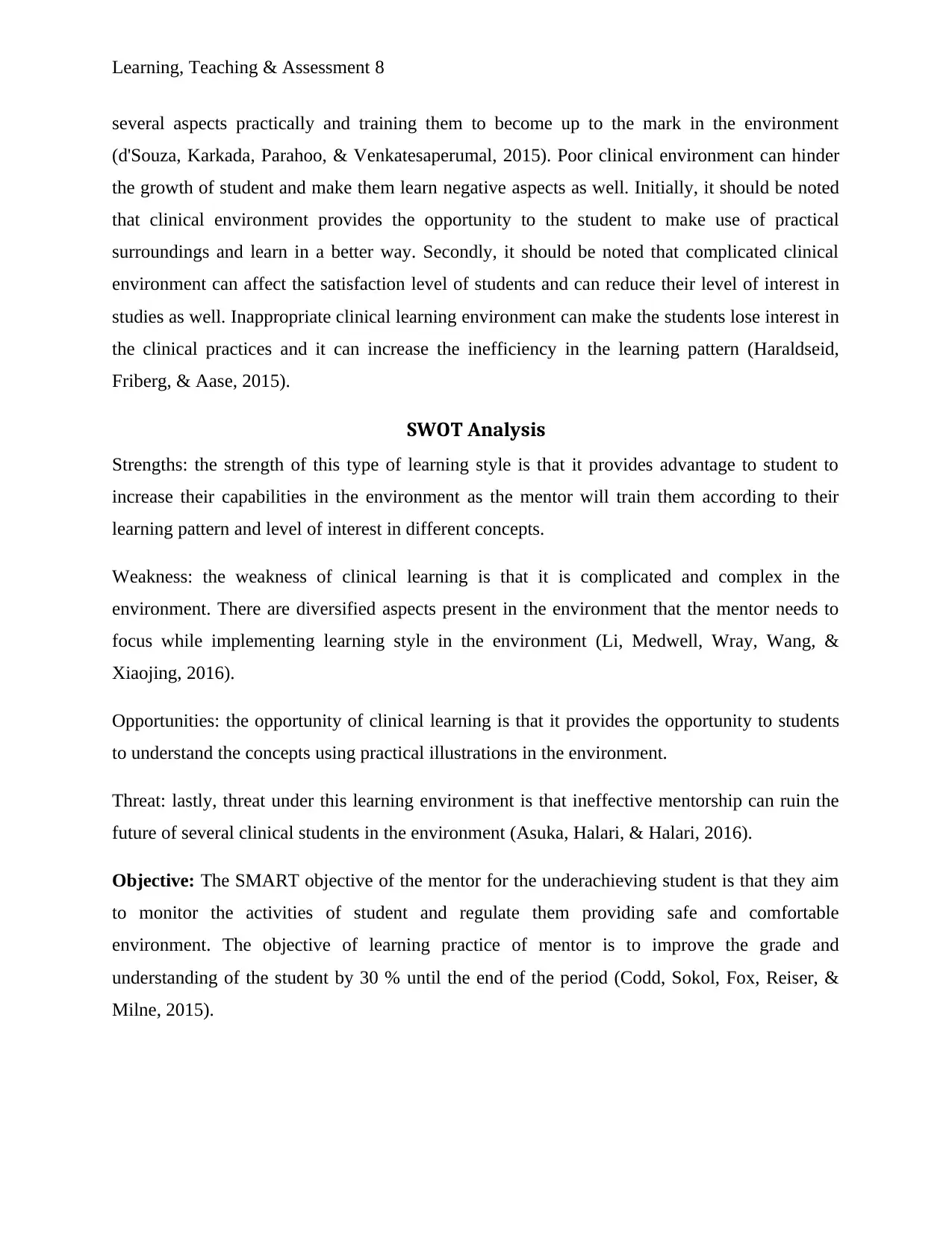
Learning, Teaching & Assessment 8
several aspects practically and training them to become up to the mark in the environment
(d'Souza, Karkada, Parahoo, & Venkatesaperumal, 2015). Poor clinical environment can hinder
the growth of student and make them learn negative aspects as well. Initially, it should be noted
that clinical environment provides the opportunity to the student to make use of practical
surroundings and learn in a better way. Secondly, it should be noted that complicated clinical
environment can affect the satisfaction level of students and can reduce their level of interest in
studies as well. Inappropriate clinical learning environment can make the students lose interest in
the clinical practices and it can increase the inefficiency in the learning pattern (Haraldseid,
Friberg, & Aase, 2015).
SWOT Analysis
Strengths: the strength of this type of learning style is that it provides advantage to student to
increase their capabilities in the environment as the mentor will train them according to their
learning pattern and level of interest in different concepts.
Weakness: the weakness of clinical learning is that it is complicated and complex in the
environment. There are diversified aspects present in the environment that the mentor needs to
focus while implementing learning style in the environment (Li, Medwell, Wray, Wang, &
Xiaojing, 2016).
Opportunities: the opportunity of clinical learning is that it provides the opportunity to students
to understand the concepts using practical illustrations in the environment.
Threat: lastly, threat under this learning environment is that ineffective mentorship can ruin the
future of several clinical students in the environment (Asuka, Halari, & Halari, 2016).
Objective: The SMART objective of the mentor for the underachieving student is that they aim
to monitor the activities of student and regulate them providing safe and comfortable
environment. The objective of learning practice of mentor is to improve the grade and
understanding of the student by 30 % until the end of the period (Codd, Sokol, Fox, Reiser, &
Milne, 2015).
several aspects practically and training them to become up to the mark in the environment
(d'Souza, Karkada, Parahoo, & Venkatesaperumal, 2015). Poor clinical environment can hinder
the growth of student and make them learn negative aspects as well. Initially, it should be noted
that clinical environment provides the opportunity to the student to make use of practical
surroundings and learn in a better way. Secondly, it should be noted that complicated clinical
environment can affect the satisfaction level of students and can reduce their level of interest in
studies as well. Inappropriate clinical learning environment can make the students lose interest in
the clinical practices and it can increase the inefficiency in the learning pattern (Haraldseid,
Friberg, & Aase, 2015).
SWOT Analysis
Strengths: the strength of this type of learning style is that it provides advantage to student to
increase their capabilities in the environment as the mentor will train them according to their
learning pattern and level of interest in different concepts.
Weakness: the weakness of clinical learning is that it is complicated and complex in the
environment. There are diversified aspects present in the environment that the mentor needs to
focus while implementing learning style in the environment (Li, Medwell, Wray, Wang, &
Xiaojing, 2016).
Opportunities: the opportunity of clinical learning is that it provides the opportunity to students
to understand the concepts using practical illustrations in the environment.
Threat: lastly, threat under this learning environment is that ineffective mentorship can ruin the
future of several clinical students in the environment (Asuka, Halari, & Halari, 2016).
Objective: The SMART objective of the mentor for the underachieving student is that they aim
to monitor the activities of student and regulate them providing safe and comfortable
environment. The objective of learning practice of mentor is to improve the grade and
understanding of the student by 30 % until the end of the period (Codd, Sokol, Fox, Reiser, &
Milne, 2015).
⊘ This is a preview!⊘
Do you want full access?
Subscribe today to unlock all pages.

Trusted by 1+ million students worldwide
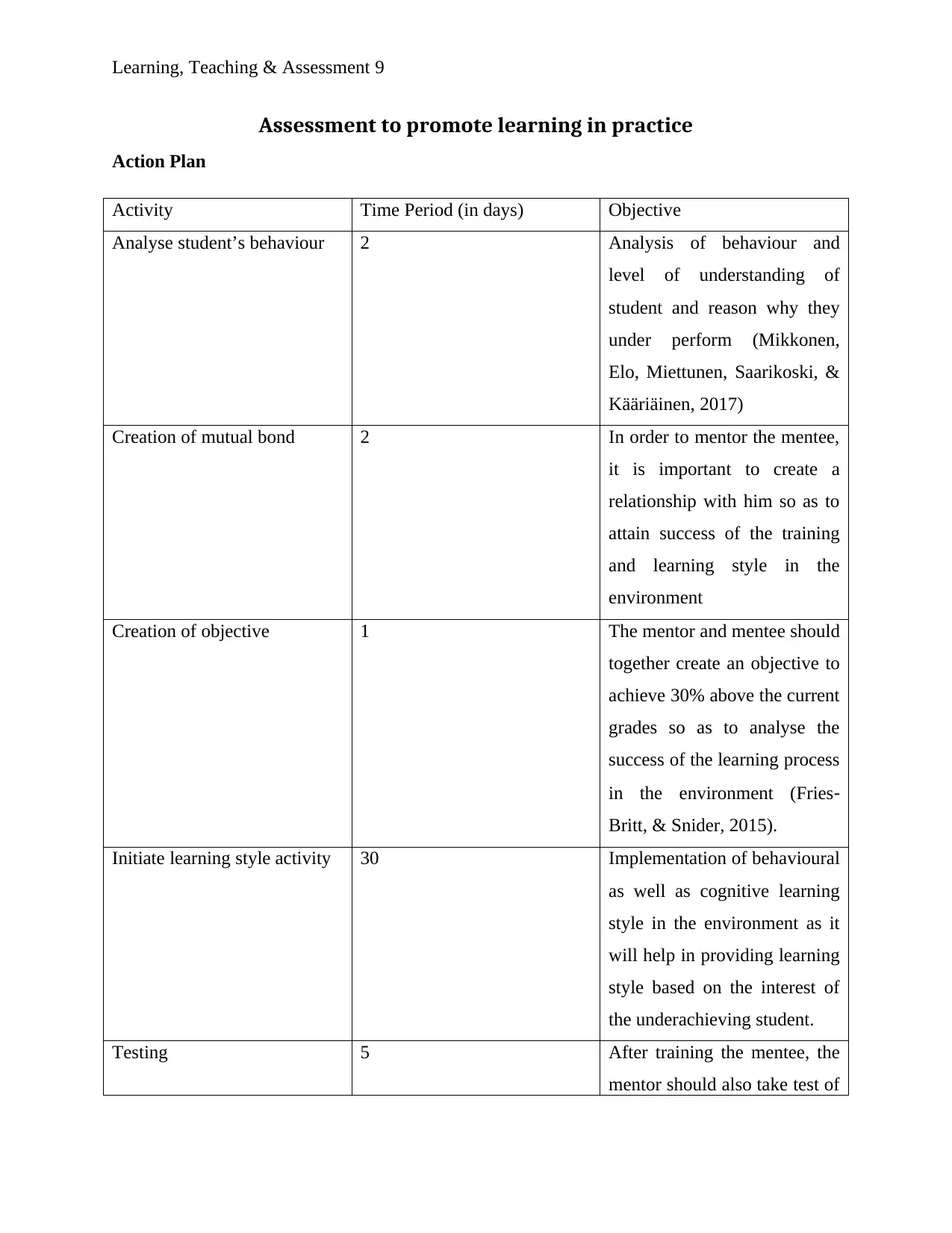
Learning, Teaching & Assessment 9
Assessment to promote learning in practice
Action Plan
Activity Time Period (in days) Objective
Analyse student’s behaviour 2 Analysis of behaviour and
level of understanding of
student and reason why they
under perform (Mikkonen,
Elo, Miettunen, Saarikoski, &
Kääriäinen, 2017)
Creation of mutual bond 2 In order to mentor the mentee,
it is important to create a
relationship with him so as to
attain success of the training
and learning style in the
environment
Creation of objective 1 The mentor and mentee should
together create an objective to
achieve 30% above the current
grades so as to analyse the
success of the learning process
in the environment (Fries‐
Britt, & Snider, 2015).
Initiate learning style activity 30 Implementation of behavioural
as well as cognitive learning
style in the environment as it
will help in providing learning
style based on the interest of
the underachieving student.
Testing 5 After training the mentee, the
mentor should also take test of
Assessment to promote learning in practice
Action Plan
Activity Time Period (in days) Objective
Analyse student’s behaviour 2 Analysis of behaviour and
level of understanding of
student and reason why they
under perform (Mikkonen,
Elo, Miettunen, Saarikoski, &
Kääriäinen, 2017)
Creation of mutual bond 2 In order to mentor the mentee,
it is important to create a
relationship with him so as to
attain success of the training
and learning style in the
environment
Creation of objective 1 The mentor and mentee should
together create an objective to
achieve 30% above the current
grades so as to analyse the
success of the learning process
in the environment (Fries‐
Britt, & Snider, 2015).
Initiate learning style activity 30 Implementation of behavioural
as well as cognitive learning
style in the environment as it
will help in providing learning
style based on the interest of
the underachieving student.
Testing 5 After training the mentee, the
mentor should also take test of
Paraphrase This Document
Need a fresh take? Get an instant paraphrase of this document with our AI Paraphraser
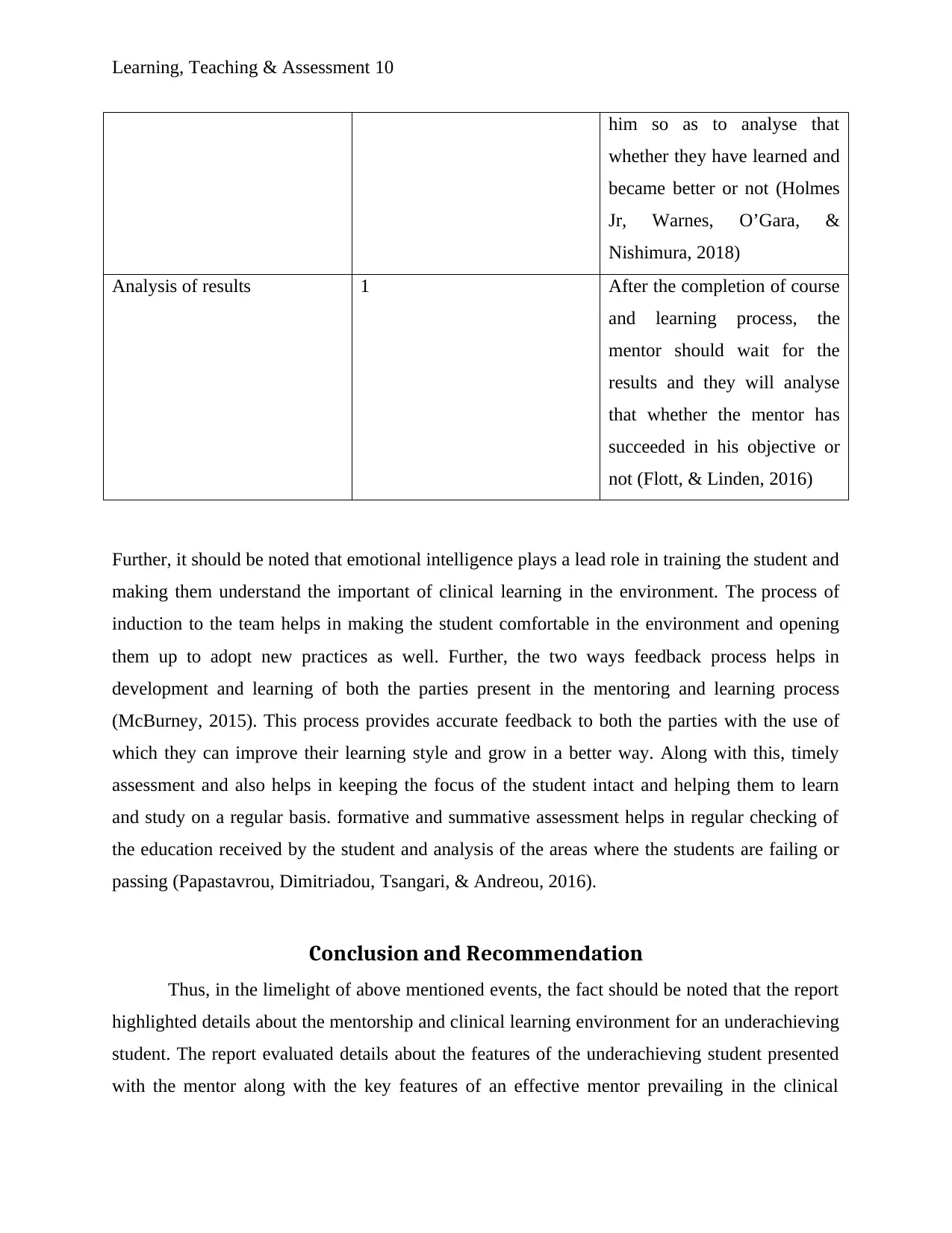
Learning, Teaching & Assessment 10
him so as to analyse that
whether they have learned and
became better or not (Holmes
Jr, Warnes, O’Gara, &
Nishimura, 2018)
Analysis of results 1 After the completion of course
and learning process, the
mentor should wait for the
results and they will analyse
that whether the mentor has
succeeded in his objective or
not (Flott, & Linden, 2016)
Further, it should be noted that emotional intelligence plays a lead role in training the student and
making them understand the important of clinical learning in the environment. The process of
induction to the team helps in making the student comfortable in the environment and opening
them up to adopt new practices as well. Further, the two ways feedback process helps in
development and learning of both the parties present in the mentoring and learning process
(McBurney, 2015). This process provides accurate feedback to both the parties with the use of
which they can improve their learning style and grow in a better way. Along with this, timely
assessment and also helps in keeping the focus of the student intact and helping them to learn
and study on a regular basis. formative and summative assessment helps in regular checking of
the education received by the student and analysis of the areas where the students are failing or
passing (Papastavrou, Dimitriadou, Tsangari, & Andreou, 2016).
Conclusion and Recommendation
Thus, in the limelight of above mentioned events, the fact should be noted that the report
highlighted details about the mentorship and clinical learning environment for an underachieving
student. The report evaluated details about the features of the underachieving student presented
with the mentor along with the key features of an effective mentor prevailing in the clinical
him so as to analyse that
whether they have learned and
became better or not (Holmes
Jr, Warnes, O’Gara, &
Nishimura, 2018)
Analysis of results 1 After the completion of course
and learning process, the
mentor should wait for the
results and they will analyse
that whether the mentor has
succeeded in his objective or
not (Flott, & Linden, 2016)
Further, it should be noted that emotional intelligence plays a lead role in training the student and
making them understand the important of clinical learning in the environment. The process of
induction to the team helps in making the student comfortable in the environment and opening
them up to adopt new practices as well. Further, the two ways feedback process helps in
development and learning of both the parties present in the mentoring and learning process
(McBurney, 2015). This process provides accurate feedback to both the parties with the use of
which they can improve their learning style and grow in a better way. Along with this, timely
assessment and also helps in keeping the focus of the student intact and helping them to learn
and study on a regular basis. formative and summative assessment helps in regular checking of
the education received by the student and analysis of the areas where the students are failing or
passing (Papastavrou, Dimitriadou, Tsangari, & Andreou, 2016).
Conclusion and Recommendation
Thus, in the limelight of above mentioned events, the fact should be noted that the report
highlighted details about the mentorship and clinical learning environment for an underachieving
student. The report evaluated details about the features of the underachieving student presented
with the mentor along with the key features of an effective mentor prevailing in the clinical
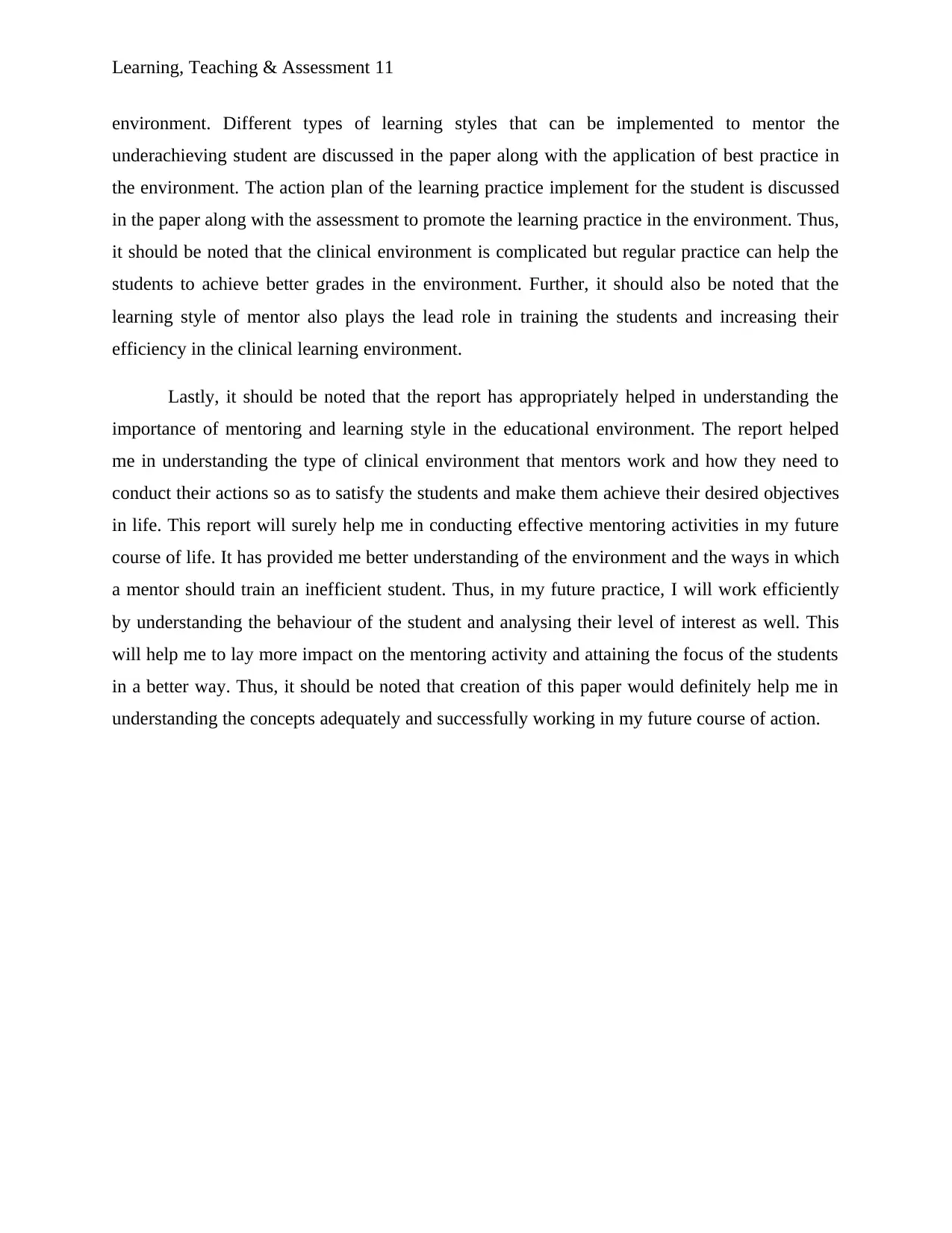
Learning, Teaching & Assessment 11
environment. Different types of learning styles that can be implemented to mentor the
underachieving student are discussed in the paper along with the application of best practice in
the environment. The action plan of the learning practice implement for the student is discussed
in the paper along with the assessment to promote the learning practice in the environment. Thus,
it should be noted that the clinical environment is complicated but regular practice can help the
students to achieve better grades in the environment. Further, it should also be noted that the
learning style of mentor also plays the lead role in training the students and increasing their
efficiency in the clinical learning environment.
Lastly, it should be noted that the report has appropriately helped in understanding the
importance of mentoring and learning style in the educational environment. The report helped
me in understanding the type of clinical environment that mentors work and how they need to
conduct their actions so as to satisfy the students and make them achieve their desired objectives
in life. This report will surely help me in conducting effective mentoring activities in my future
course of life. It has provided me better understanding of the environment and the ways in which
a mentor should train an inefficient student. Thus, in my future practice, I will work efficiently
by understanding the behaviour of the student and analysing their level of interest as well. This
will help me to lay more impact on the mentoring activity and attaining the focus of the students
in a better way. Thus, it should be noted that creation of this paper would definitely help me in
understanding the concepts adequately and successfully working in my future course of action.
environment. Different types of learning styles that can be implemented to mentor the
underachieving student are discussed in the paper along with the application of best practice in
the environment. The action plan of the learning practice implement for the student is discussed
in the paper along with the assessment to promote the learning practice in the environment. Thus,
it should be noted that the clinical environment is complicated but regular practice can help the
students to achieve better grades in the environment. Further, it should also be noted that the
learning style of mentor also plays the lead role in training the students and increasing their
efficiency in the clinical learning environment.
Lastly, it should be noted that the report has appropriately helped in understanding the
importance of mentoring and learning style in the educational environment. The report helped
me in understanding the type of clinical environment that mentors work and how they need to
conduct their actions so as to satisfy the students and make them achieve their desired objectives
in life. This report will surely help me in conducting effective mentoring activities in my future
course of life. It has provided me better understanding of the environment and the ways in which
a mentor should train an inefficient student. Thus, in my future practice, I will work efficiently
by understanding the behaviour of the student and analysing their level of interest as well. This
will help me to lay more impact on the mentoring activity and attaining the focus of the students
in a better way. Thus, it should be noted that creation of this paper would definitely help me in
understanding the concepts adequately and successfully working in my future course of action.
⊘ This is a preview!⊘
Do you want full access?
Subscribe today to unlock all pages.

Trusted by 1+ million students worldwide
1 out of 14
Related Documents
Your All-in-One AI-Powered Toolkit for Academic Success.
+13062052269
info@desklib.com
Available 24*7 on WhatsApp / Email
![[object Object]](/_next/static/media/star-bottom.7253800d.svg)
Unlock your academic potential
Copyright © 2020–2025 A2Z Services. All Rights Reserved. Developed and managed by ZUCOL.





